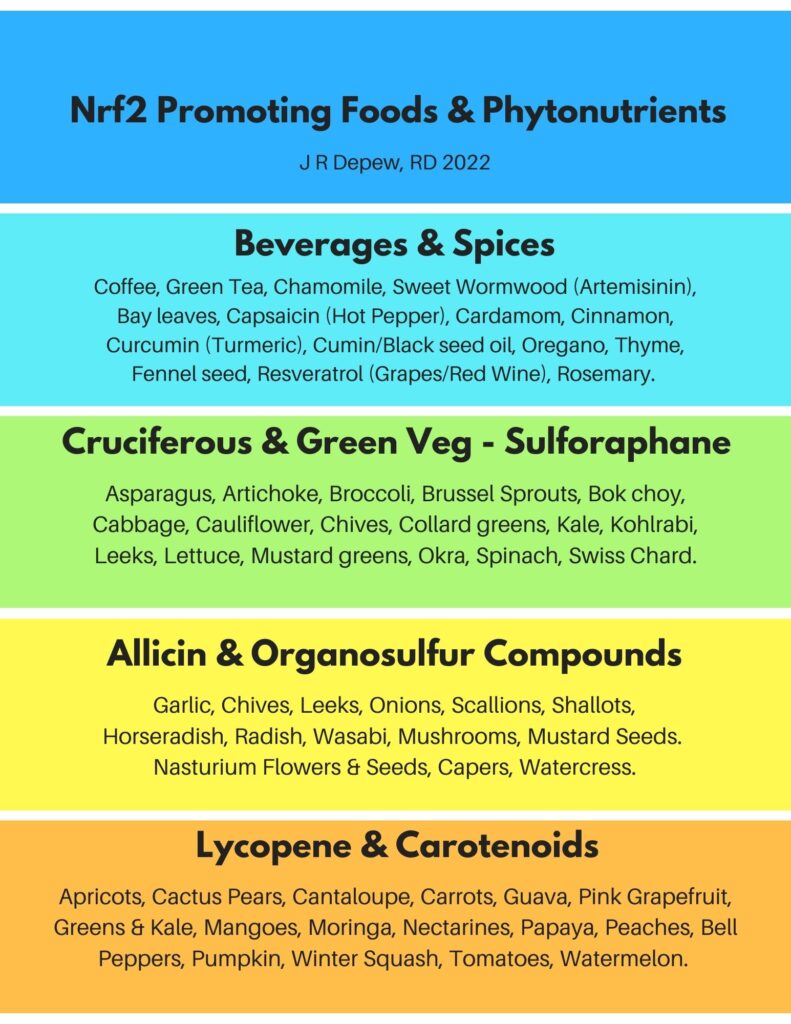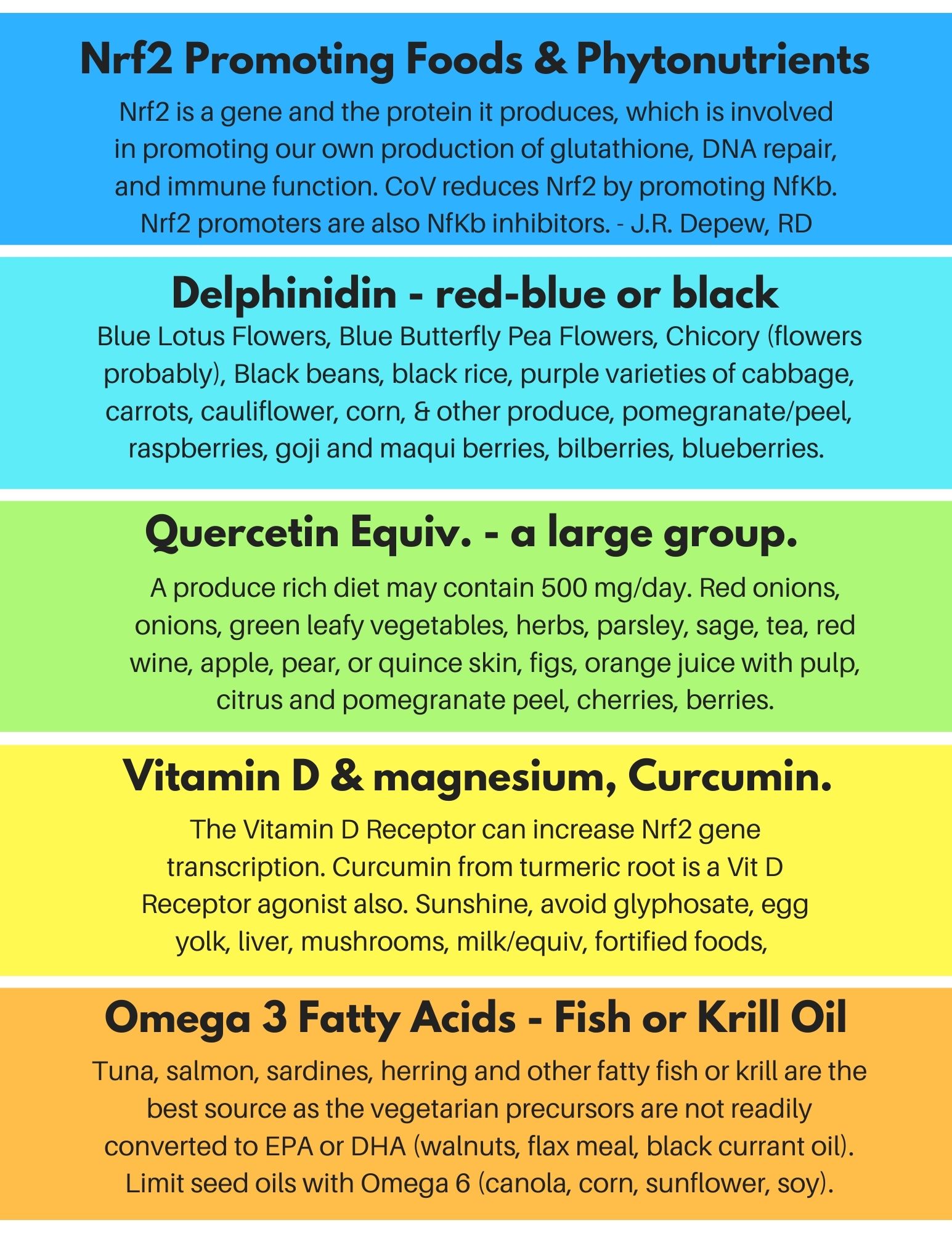Number one on my list of need to know things about chimeric spike – ankyrin binding domains are in TRP channels and are disrupted.
Disruption of TRPV-1 channel function by spike protein due to the ankyrin repeat domains may affect a variety of functions in the body including hearing and cause other symptoms resembling Covid19. Liviero, et al, noted the TRPV1 symptoms and suggest trying inhibitors or down-regulators, (Liviero, et al, 2021) , however TRP channels have multiple functions and just inhibiting them has not worked for other conditions. Methyl B12, zinc and magnesium may be protective for hearing. Saffron may help and adequate protein. Word of mouth feedback – tuna fish regularly in the diet helped restore taste sensations. It is a good source of methyl B12 and zinc and protein.
Magnesium is essential for 80% of our body’s function (post) & need is increased by inflammation or infection. Topical source may be critical for spike protein symptoms.
Chimeric spike protein may be disrupting TRP ion channel function which would negatively effect hearing, taste, and odor perception, and increase pain. Magnesium is a protector for TRP channels, it helps keep the ‘doorway’ closed from the inside.
To bypass the reduced intestinal absorption of magnesium ions, chelated supplements or topical sources are needed. The topical Epsom salt magnesium would be absorbed through larger hair follicle pores. (post) Topical Epsom salt soaks is a well absorbed form of magnesium and the sulfate is beneficial also – heart smart even.
1-2 cups Epsom salt to a half bath, soak for 20-40 minutes; or in a big bucket, 1 cup salt, soak lower legs for 40 minutes – that can help whole body symptoms too, but the full body effect of a bath is nicer, especially if there are scalp or ear issues – gets the magnesium and sulfate right to the area. (Epsom salt footsoaks)
Tinnitus is a risk from damaged hair cells in the inner ear and magnesium and sulfate, and hydration, are all protective of the fragile hair cells. Once damaged they do not really grow back. Protection from loud sounds is also helpful. TRP channels also have a spring like device that can sense pressure changes – which are made from the ankyrin repeat domain which the chimeric spike protein can disrupt. A different type of TRP channel is involved in intestinal absorption of magnesium ions which do not have ankyrin repeat domains. (Nilius, et al, 2007)
Ferroptosis – anemia of chronic infection/inflammation – severe fatigue.
The body will shift iron out of hemoglobin to protect it from suspected pathogens. In severe CoV, the normal response is overactive and can continue in LongCovid. Too little hemoglobin means too little oxygen, and extreme fatigue. Too much iron elsewhere can lead to cell damage from oxidative stress – ‘rust’ caused by electrically active iron. Thread about ferroptosis, with ref and ref and images.
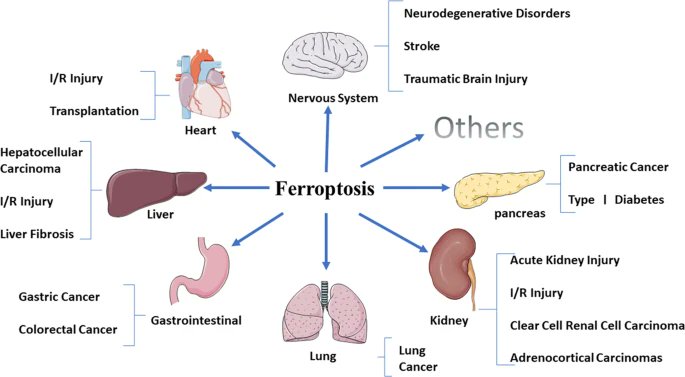
Eating too much, carbohydrates and glutamate seasonings, can greatly increase the risk of ferroptosis – excess free iron and oxidative stress, and lead to increased blood sugar and insulin resistance.
“It is now accepted that nutrient abundance in the blood, especially glucose, leads to the generation of reactive oxygen species (ROS), ultimately leading to increased oxidative stress in a variety of tissues. In the absence of an appropriate compensatory response from antioxidant mechanisms, the cell, or indeed the tissue, becomes overwhelmed by oxidative stress, leading to the activation of intracellular stress-associated pathways. Activation of the same or similar pathways also appears to play a role in mediating insulin resistance, impaired insulin secretion, and late diabetic complications. The ability of antioxidants to protect against the oxidative stress induced by hyperglycemia and elevated free fatty acid (FFA) levels in vitro suggests a causative role of oxidative stress in mediating the latter clinical conditions. “ (Newsholme, et al, 2019) (ref)
The graphic by Newsholme, et al, 2019, below, (ref), shows the Krebs cycle, also called the Citric Acid Cycle, in the top left:
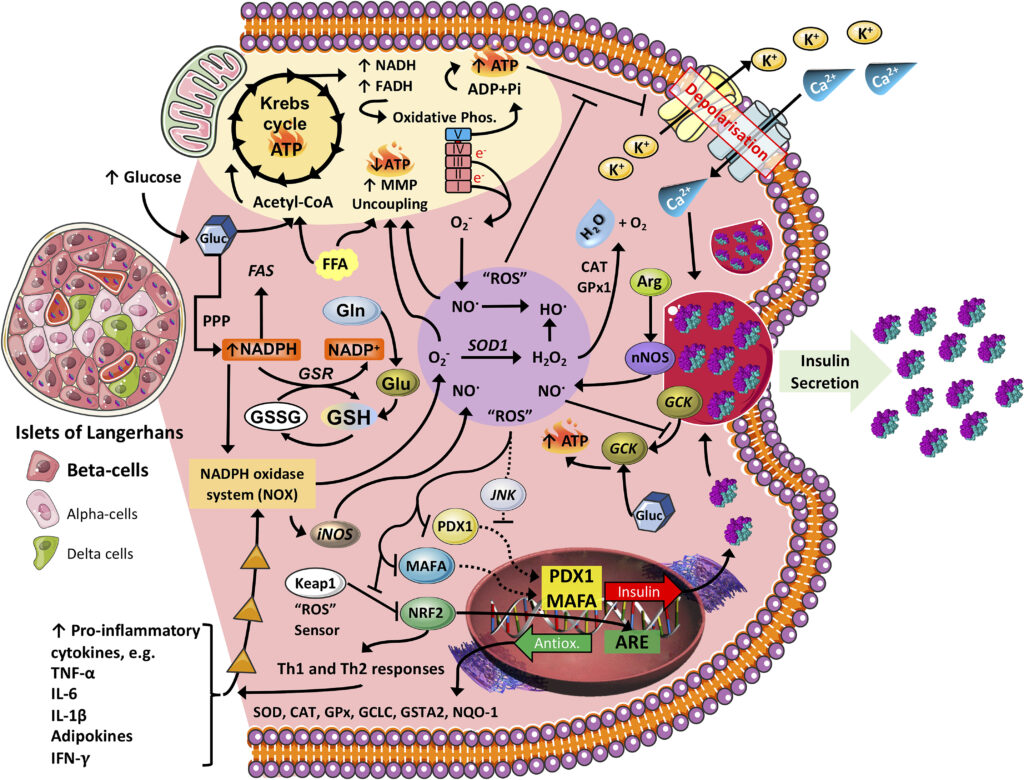
The Islets of Langerhans are cell clusters in the pancreas (on the left side of the image above) involved with producing insulin as needed, (on the right side of image).
More and more sugar, glucose or carbohydrates including fruit (fruit has fructose and glucose), leads to more and more insulin production. Not shown in this image is the effect on fat cells – once overloaded they can become insulin resistant and no longer respond to insulin by taking up the excess glucose in the blood stream – the glucose and the insulin become elevated, excessive.
The point in sharing the image is not to suggest you need to understand it all – but to see the complexity – and the basic point – more glucose/sugar leads to more insulin. If that continues over many years the pancreas cells can become damaged from too much “ROS” = Reactive Oxidative Stress (circle in the very center of the image.
An iNOS inhibitor would be helpful. See the lower left corner showing Pro-inflammatory cytokines: TNF-alpha, IL-6, IL-1beta, Adipkines, IFN-gamma. The inflammatory cytokines lead to increased activity of the NADPH oxidase system (NOX) which promotes iNOS, which makes Nitric oxide (NO), which helps increase the ROS – reactive oxidative stress when in excess. Nitric oxide can be helpful for health in the correct amounts.
Chalcones are the basic unit of flavonoids that provide a yellow pigment in many flowers. Types of chalcones are found in many plant foods and they have anti-microbial and anti-inflammatory effects. (Muraleedharan KM, et al., 2007) (ref) Chalcone flavonoids may help by inhibiting iNOS, (Young Hoon Kim, et al, 2007) (ref), so less Nitric oxide (NO) is made. In very severe oxidative stress excess nitric oxide may crystallize into a solid mass, disrupting function of cell function.
Chalcones:
“Indeed, chalcones constitute an important group of natural compounds that are especially abundant in fruits (e.g., citruses, apples), vegetables (e.g., tomatoes, shallots, bean sprouts, potatoes) and various plants and spices (e.g., licorice),—many of which have been used for centuries in traditional herbal medicine [29]. ” (Orlikova, 2011) (ref)
Whole licorice root, not the deglycyrrhised form, is a traditional medicinal herb used in Chinese medicine and has been used elsewhere as a herbal remedy. Citrus peel is a very good source of the chalcone called naringenin. Pomegranate peel is also a very good source of chalcones, (ref), and cinnamon is too. (ref)
Anemia of Chronic Inflammation can be a result of excessive ferroptosis.
- See the later half of this post for more info about anemia of chronic inflammation: Artemisinin, arteannuin-b, sgp130Fc, and Covid-19.
- The post also has a link to my unfinished book: Tipping the Clock Towards Health, which is available for sale, updates would be emailed to purchasers. (LeanPub/Tipping the Clock) *Which I have added to but it is still incomplete as of this page update on Feb. 6, 2024.
In researching anti-inflammatory phytonutrients I learned that the same foods that increase the anti-inflammatory Nrf2 pathway also inhibit the inflammatory Nf-Kb pathways. Many foods and nutrients can do both – promote anti-inflammatory Nrf2 and inhibit Nf-Kb. We hear a lot about sulforaphane and broccoli sprouts – research has shown it to be a rich source of Nrf2 promoting power – but there are oodles of other tasty choices:
That led to my learning that circadian chemistry uses the same proteins for the two pathways – so it has to be an either/or choice between the chemical pathways. It is a night/day ‘choice’ of modern life. In more ancient times people didn’t have bright light in the evening or at night. The glow of a campfire doesn’t disrupt circadian chemistry the way bright blue containing light can.
Aim for doing the opposite of the following list:
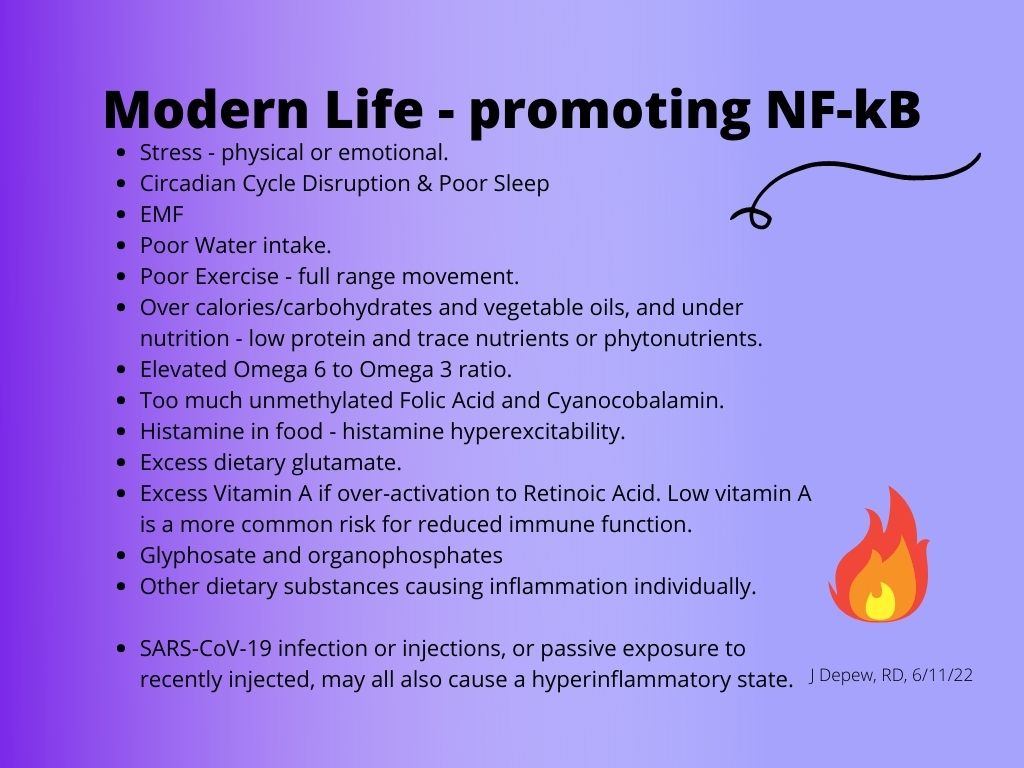
Vitamin C and iron chelators are needed, and it would also help to avoid iron rich foods in quantity. Some is reasonable, snacking on fortified breakfast cereal or liver and onions would likely be adding to the body’s inflammatory load. Methyl B complex would also be helpful to restore normal red blood cell growth within the bone marrow. Growing more healthy red blood cells is the goal so adequate protein intake is also needed.
Iron chelators:
Quercetin is in citrus peel, EGCG in pomegranate peel or 3 cups green tea per day, Resveratrol, Artemisinin or wormwood as tea, 10 gr/day goal is used to prevent malaria, Hydroxychloroquine, HCQ, or Cinchona bark tea/extract (source of quinine), Lactoferrin, fisetin, or cloves/clove essential oil. (cloves, ref, ref)
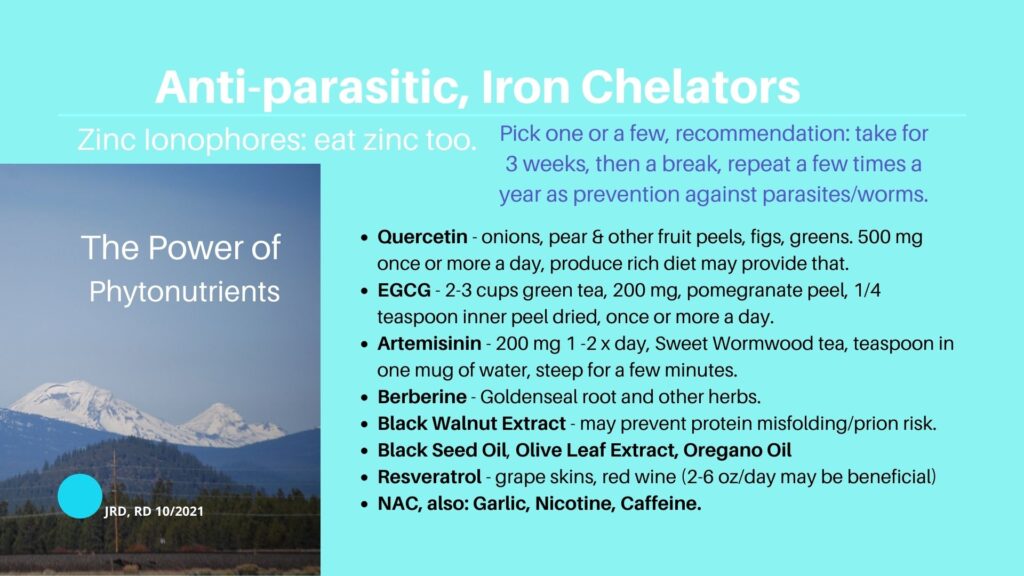
More info about this is in the Health Aids for Special Times document:
Health Aids for Special Times – document with link to Spanish translation.
- Health Aids for Special Times – phytonutrients, foods, other aids that may help with removing cellular debris such as a chimeric spike protein, and reduce inflammation. (document)
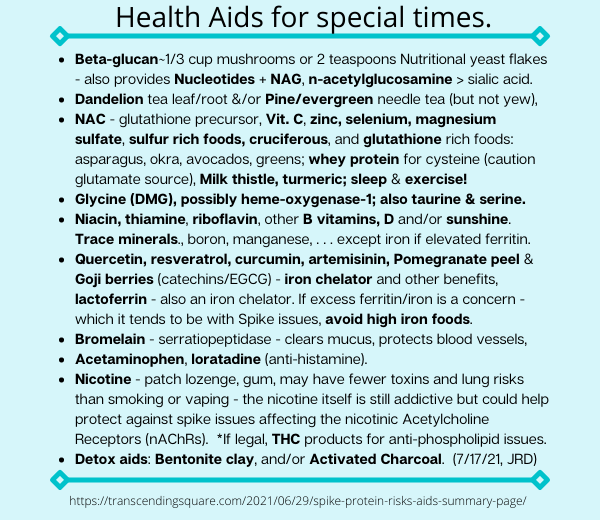
General guidance –
See Page: Self Care Posts
- Do not overeat. In order to remove cellular debris the body needs to be a little hungry for a while and the white blood cells need to be not busy storing excess calories from a day of eating more food than was needed – search words: autophagy, intermittent fasting.
- Have adequate protein, preventing ‘sarcopenia‘ is important for older adults. Goal: 20-30 grams of protein at breakfast, lunch and dinner, may be helpful to prevent muscle loss. It occurs as we age more due to increased breakdown of muscle tissue and more difficulty building it. DHEA supplements starting around age 35 may be preventive also, (25 mg for females or less, 50-100 mg for males may be used, check into it more before trying).
- It can be helpful to limit carbohydrates compared to the average balance of the standard diet – search words on this site: 30% carbohydrates.
Circadian cycle is critical for healthy detoxification of the days inflammatory activity. Complete blackout is best and avoid electronic screen blue light for the last 3 hours before sleep – or wear blue light blocking glasses. Get full spectrum light in the morning hours of the day to help get the body back into daytime mode. Many genes are activated or inactivated for use in the day or night during normal health. Modern life seems to keep us in the inflammatory daytime mode all of the time. The glowing alarm clock light is a negative factor for our health.
- Sunshine or full spectrum lamps that have UV can help us make more than just vitamin D. Water soluble versions of vitamin A and D are also produced within the skin when sunshine is available. Mood and health may be helped more by providing full spectrum lighting in our homes, offices, schools, and healthcare facilities, than by depending on vitamin D supplements.
- Moderate dose vitamin D supplements taken in advance of an infectious exposure can reduce risk of infection, or risk of an overactive immune response that leads to excessive inflammation and possibly autoimmune antibodies. 600-1000 IU would be a moderate daily dose.
Microbiome health is also critical for our own physical and mental health, and our beneficial microbe species can be a frontline defense against pathogens.
- We need to eat food that the beneficial species need for their best health – or the negative species that can survive on less healthy food multiply in greater numbers instead.
- Resistant starch, fiber foods, pomegranate/peel and other phytonutrient rich produce, and plenty of zinc, all help to promote the growth of more beneficial species of digestive microbes – and they also make helpful nutrients for us out of the fiber that we can’t digest for ourselves.
- Negative species of the gut microbiome may make histamine and add to histamine excess or MCAS symptoms. Some species make endotoxins like Lipopolysaccharide (LPS) which is a chemical that adds to inflammation. Chimeric spike issues include worsening the effects of LPS.
- There is a Microbiome page and two pages on Resistant Starch on the site jenniferdepew.com and one on Histamine/MCAS.
Mitochondrial support helps protect against many chronic degenerative conditions. Niacin and other B vitamins, magnesium, manganese, CoQ10, alpha lipoic acid, and a couple amino acids are needed in good supply, every day. The B vitamins are water soluble, so we can not store any extra and need more daily. See page Prenatal/Child on jenniferdepew.com for more on this topic.
- B vitamins: B1 (Thiamin) (3) , B2 (Riboflavin) (4), B3 (Niacin) (8, 10), B5 (Pantothenic acid) (5), B6 (Pyridoxine) (6, 7), B7 (Biotin), B9 (Folate) (9),
- Minerals (17): Mg++ (Magnesium) (11, 12, 13), Mn++ (Manganese), K+ (Potassium) (13), Zinc (14, 15), Iron (16), Copper, Sulfate,
- Amino acids: Carnitine (derived from lysine), Cysteine,
- Antioxidants: CoQ10, Glutathione, Alpha-Lipoic Acid (ALA).
- See: Niacin may help prevent or treat migraines.
Manganese (and methionine and amino acid) may be reduced in the food supply due to glyphosate use on crops, it is a mineral chelator – holds the manganese in the soil along with other minerals. Manganese deficiency is likely a big issue in severe CoV, especially if in combination with Graphene oxide, GO, and EMF energy field exposure (turn off WiFi at night). The mitochondria need plenty of manganese, but not too much, not a megadose. See: RBCs, Rouleaux formation, & Mineral deficiency.
Disclaimer: This information is being provided for educational purposes within the guidelines of Fair Use and is not intended to provide individual health care guidance.

